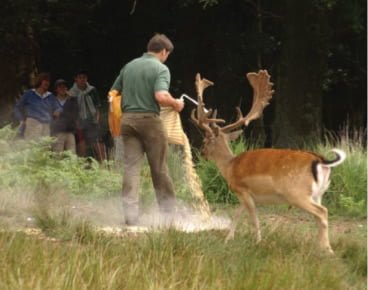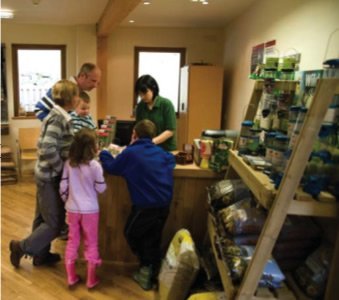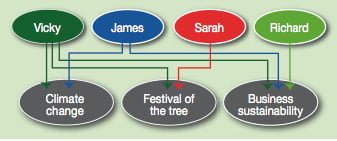
The Forestry Commission has a huge responsibility. It cares for 827,000 hectares of sustainably managed woods and forests and plants more than 17 million trees a year. Its mission is: ‘to protect and expand Britain”s forests and woodlands and increase their value to society and the environment.’
The Forestry Commission is a government department which employs over 3,000 workers across Britain. Its goal is to ensure that Britain can use its forests to contribute positively to as many of the nation’s needs as possible, both now and in the future.
To do this, it works with a range of partners such as landowners, local authorities, communities and national businesses. Its responsibilities cover timber production, research, recreation, education and managing the national forest estates. All of this is done as sustainably as possible without affecting the future use of resources.
Climate change is one of the biggest challenges facing the world today. Britain’s trees and forests have an important contribution to make in addressing climate change. There are two ways to reduce the level of carbon dioxide in the atmosphere:
- Reduce the amount we produce
- Develop ways to capture and store the emissions we cannot avoid.
Trees have the unique ability to do both.
This case study shows how the important roles played by people who work for the Commission are structured. It outlines how this structure helps the Forestry Commission in its vital role in protecting Britain’s forests.
Organisational structure
Organisational structure refers to the way that roles are organised within a firm. The structure is often represented in a diagram called an organisation chart. Many organisations are typically set up in a hierarchical structure. This is where workers are divided into management layers, with those in the top levels having greater authority than those in lower levels. Instructions are passed down through the layers along the chain of command. An organisation’s structure should be designed to deliver goals and use resources in the best possible way.
Organisations may be structured by product, function or geography. Department stores, for example, are structured by product, e.g. menswear, cosmetics, home wares. UK government departments are structured by function, for example, Health or Education.

The Board of Commissioners is responsible for overseeing the work of the Forestry Commission across Great Britain as a whole. However, there are national committees for each of Scotland, England and Wales. The Forestry Commission therefore is structured by geography.
This geographical structure has two main advantages. Firstly, it creates a regional base allowing decisions in Scotland, Wales and England to be made and managed at a regional level. This takes into account local conditions, needs and expertise.
Delegating decision-making down the hierarchy is referred to as decentralisation. Each country is engaged in:
- Forest management activities on the government’s forest estate, such as planting and harvesting trees, recreation or education
- Conservation activities for the protection and re-planting of trees and nature sites owned by private sector landowners.
The Forestry Commission’s structure also allows it to benefit from centralisation. While forest policy differs between the three countries, some internal policy decisions are still made at the top of the hierarchy. This ensures consistency where necessary throughout the whole of the Forestry Commission, for example, making certain that Britain adheres to international rules for sustainable forest management.
Centralisation also provides benefits from economies of scale, e.g. by having central departments to provide shared services, including Human Resources, Finance and Information Services.
Roles within the organisation
An organisational chart shows the pattern of relationships between the different workers in a firm. How these different roles interact will depend on the aims, objectives or culture of the organisation.
The Forestry Commission is an organisation that values people. Individual members of staff are given a lot of responsibility and are encouraged to make decisions themselves where appropriate.

The Commission works to a values statement setting out how people are expected to work together. The values are based on:
- Teamwork working as teams with colleagues and others to ensure that trees, woods and forests meet the needs of people in each part of Britain
- Professionalism enjoying and taking pride in work, achieving high standards of quality, efficiency and sustainability
- Respect treating one another with consideration and trust, recognising each person’s contribution
- Communication is open, honest and straightforward with colleagues and others, as willing to listen as to tell
- Learning always learning from outside the Forestry Commission as well as from within
- Creativity not being afraid to try new ways of doing things.

People who work for the Forestry Commission have clearly defined roles, but work within teams. For example:
James is a Programme Group Manager in the Commission”s Forest Research Agency in the South of England.
‘I provide the scientific evidence to help decide where new tree planting should take place. The Commission has to make the public understand that in some situations it is ok to cut down trees – if you replant. I joined the Forestry Commission as this offered me the chance to take a more applied approach to use my earlier studies in Ecology at university. Working for the Commission has offered me training opportunities and the chance to move jobs within the organisation and around the country.’
Sarah is a Climate Change Interpretation Officer based at the Westonbirt Arboretum in Gloucestershire.
‘My role is to put the complex messages about climate change into simpler terms for the public as well as for fellow workers. I organise the annual “Festival of the Tree” event at the Arboretum. This is a hands-on opportunity for people to find out more about the positive effect of trees. I have also produced a DVD about climate change for schools. It’s really satisfying for me that I can take a project through from beginning to end and see how it makes a difference. I also know that I can have a long term career here because the Commission supports training and development to expand my skills.’
Vicky is a specialist adviser in the Climate Change Team in Edinburgh. She studied Maths at University.
‘My skills were a good fit as we need to have hard facts and figures to understand the impact trees can have on climate change. For example, we need to know how much carbon is stored in woodland as it grows in order to know if it can be used to offset carbon emissions. My role is to interpret the research coming out of the Forest Research team so that the Commission can develop policies based on this evidence. Jobs in government organisations are not always as practical as this. The best bit of what I do is that I can see I make a difference and have a real connection with what is happening with woodlands in Britain.’
Richard is a Business Sustainability Officer based in Dumfries in Scotland.
‘I grew up next to a forest on the North Yorkshire Moors and had my first job with the Commission when I was 13 selling Christmas trees! I studied mechanical engineering at university but afterwards took a City & Guilds qualification in agricultural engineering and forestry service engineering at college. This gave me the practical skills I needed to move into forest engineering. My team repairs and maintains the Forestry Commission’s harvesting machinery, vehicles and equipment. I have a fantastic job with lots of variety, for example, training on business sustainability and energy savings one day, installing or repairing a wind turbine the next. Being able to take ownership of a project gives me enormous job satisfaction.’
Flat organisation structures
Some hierarchies have many layers within them. This often leads to a narrow span of control. This means that each manager is responsible for only a small number of people. These tall organisations allow for tighter control and supervision but may stifle motivation or the creativity of workers. This sort of structure does not fit with the work carried out at the Forestry Commission.
The Forestry Commission has a flat organisational structure. This has fewer layers and larger spans of control. Communication is generally quicker in this structure and enables creative approaches and the freedom to explore new options.
Employees at the Forestry Commission work together to find better ways of using forest resources by:
- ‘Protecting what we already have
- Reducing deforestation
- Restoring the world’s forest cover
- Using wood for energy
- Replacing other materials with wood
- Planning to adapt to our changing climate’.
For this structure to be effective, workers need to be able to take responsibility for their decisions.
Forestry Commission employees like James, Sarah, Vicky and Richard work within a flat organisation structure. Their skills and experience are used effectively to share ideas about ways in which sustainable forestry can help to combat climate change.
The Copenhagen Accord, agreed in December 2009, gave international backing to a number of commitments for global action on climate change. The Accord added weight to recent UK initiatives including those related to sustainable forests. The Forestry Commission is actively working to support these initiatives.
Factors affecting structure
Organisations like the Forestry Commission need to identify the best structures to enable them to meet their objectives. They must also be able to respond quickly to both internal and external factors affecting their work.
Much of the work of the Forestry Commission involves project work. Examples of projects include:
- Educational projects to inform children about the importance of forests
- Climate change projects to identify current knowledge, provide ideas for reducing and adapting to climate change and identifying information gaps.
The best way of managing project work is through a matrix structure. This brings together employees from a range of different backgrounds and experience. The team members use their individual talents and skills to complete the project.
For example, James’ work includes looking at the financial implications of planting trees and how the jobs created by the Forestry Commission affect the country’s economy and people. Richard is able to develop new ideas to reduce carbon dioxide emissions and energy use. As part of Vicky’s role, she makes the complex science of climate change more understandable for everyone within the Commission, in the wider forestry sector and for the public.

Employees like James, Sarah, Vicky and Richard may work on several different projects at the same time. For example:
- James and Vicky may be part of a project sharing ideas about climate change
- At the same time, Vicky may be working with Sarah in planning the annual ‘Festival of the Tree’
- Richard may use information from James and Vicky in planning business sustainability strategies.
This type of project-based structure helps the Forestry Commission to address different issues efficiently. This contrasts with other organisations where an employee may have set tasks to do in an organised hierarchy or where there is functional specialism.
In this type of organisation, work is more routine with less opportunity for individuals to express themselves and their ideas. Working for the Forestry Commission enables employees to engage in work of national importance.
James, Programme Group Manager in the Forest Research Agency says: ‘I love the fact that my job makes a difference. Responsible management of woodlands is vital and the decisions we make today affect future generations.’
The Forestry Commission’s goal is to ensure that Britain”s forests contribute positively to protecting the environment. It does this while sustaining this great resource for the future.
To achieve this, the Forestry Commission combines both a centralised structure for Britain-wide decision-making and a decentralised structure for the management of local forests and woodland resources. In addition to this, matrix teams are used to develop the projects with which the Forestry Commission is involved.
The Forestry Commission provides a wide range of interesting jobs. It has adopted an organisational structure that allows workers to contribute and take responsibility for their actions.
Working for the Forestry Commission enables people to make a real difference.



